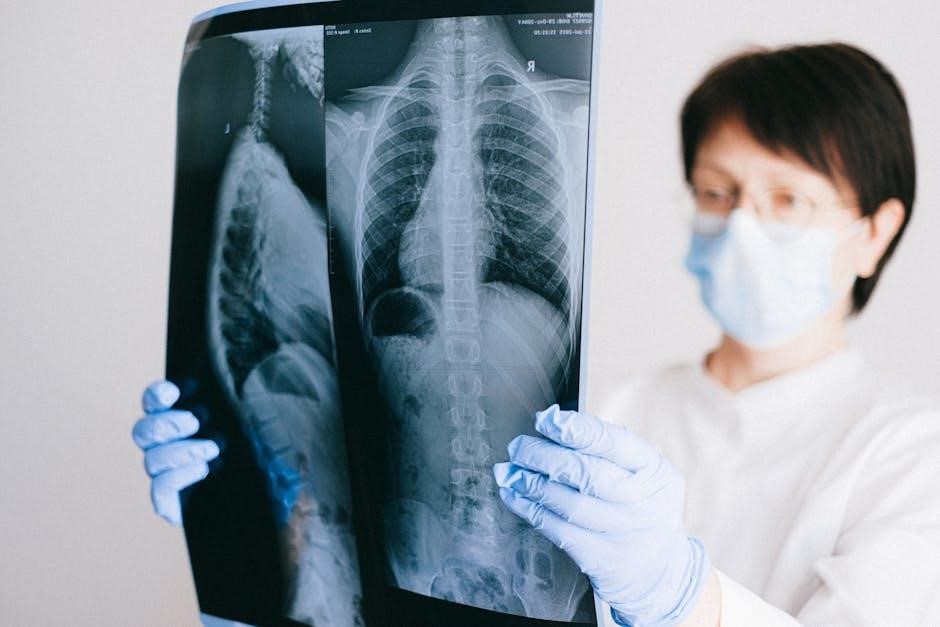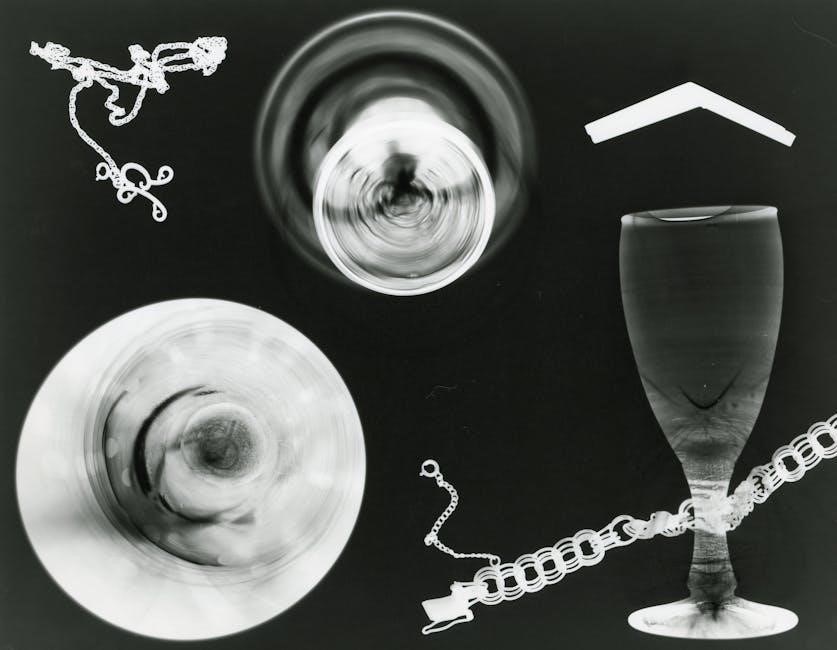Welcome to the comprehensive guide on X-ray positioning charts, essential tools for radiographers to ensure accurate patient positioning and high-quality imaging outcomes. These charts provide standardized, step-by-step guidance for various radiographic projections, supported by detailed images and diagrams. Available in formats like PDF, they enhance accessibility and convenience for clinical and educational use.
Overview of X-Ray Positioning Charts
X-ray positioning charts are detailed visual guides that outline the optimal placement of patients for various radiographic examinations. These charts, often available in PDF format, include images and diagrams to illustrate proper positioning techniques. They cover a wide range of body regions, such as chest, skull, spine, and extremities, providing step-by-step instructions for each projection. The charts also specify technical factors like central ray placement, tube angulation, and film size. Designed for radiographers and students, they ensure consistency and accuracy in imaging. Many resources, such as AuntMinnie.com and radiology textbooks, offer downloadable versions, making them accessible for clinical and educational use. These tools are indispensable for achieving high-quality X-ray images and standardizing radiographic procedures.
Importance of Proper Patient Positioning in Radiography
Proper patient positioning is critical in radiography to ensure accurate and clear images for diagnosis. Misalignment can lead to distorted images, potentially masking abnormalities or requiring repeat exposures, which increase radiation exposure. Correct positioning enhances image quality by optimizing the relationship between the X-ray beam, patient anatomy, and image receptor. It minimizes artifacts caused by improper alignment, such as foreshortening or elongation, ensuring diagnostic accuracy. Additionally, proper positioning reduces patient discomfort and streamlines the imaging process, improving efficiency in clinical settings. Radiographers rely on X-ray positioning charts to maintain consistency and achieve the best possible outcomes for both patients and healthcare providers.
Benefits of Using X-Ray Positioning Charts
The use of X-ray positioning charts offers numerous benefits in radiography, enhancing both efficiency and accuracy. These charts provide standardized protocols for patient positioning, reducing variability and ensuring consistent results. They serve as valuable educational tools for radiology students and professionals, offering clear, step-by-step guidance. The inclusion of images in charts, particularly in PDF formats, allows for easy visual reference, improving understanding and application. By standardizing techniques, these charts minimize errors and reduce the need for retakes, lowering radiation exposure for patients. Additionally, they streamline workflows in clinical settings, saving time and improving overall patient care. Their accessibility and comprehensive design make them indispensable resources for radiographers worldwide.

Understanding the X-Ray Positioning Chart with Images
X-ray positioning charts with images provide visual guidance for accurate patient positioning, ensuring proper radiographic projections. These charts, often in PDF format, simplify complex techniques, making them accessible for quick reference.
Key Components of the Chart
X-ray positioning charts are comprehensive tools that outline the essential elements for accurate radiographic imaging. They include detailed images and diagrams to illustrate proper patient positioning for various body parts, such as the chest, skull, spine, and extremities. Each chart typically provides step-by-step instructions for setting up the patient, including the correct posture, alignment, and placement of body landmarks. Additionally, they specify technical factors like central ray placement, tube angulation, and optimal film size. The charts also highlight collimation and exposure settings to ensure high-quality images while minimizing radiation exposure. Many charts are available in downloadable PDF formats, making them easily accessible for radiographers and students. These visual aids are indispensable for both clinical practice and educational training.

How to Read and Interpret the Chart
X-ray positioning charts are designed to be user-friendly, with clear visuals and detailed instructions. Start by identifying the specific body region and projection, as each chart is organized by anatomical area. The charts often include high-quality images or diagrams that illustrate the correct patient positioning, making it easier to replicate in clinical settings. Pay attention to labels and annotations that highlight key landmarks, such as the central ray placement or tube angulation. Technical specifications, such as exposure factors and film size, are typically listed alongside the images. To interpret effectively, follow the step-by-step guides and cross-reference the visual aids with written instructions. This ensures accurate positioning and optimal image quality. Regular practice and familiarity with the chart enhance proficiency in its use.
Role of Images in the Chart
Images play a vital role in X-ray positioning charts, serving as visual guides to ensure accurate patient positioning. They provide clear, detailed illustrations of anatomical landmarks, optimal patient placement, and beam alignment. High-quality diagrams and examples help radiographers understand complex setups, reducing errors. The images often depict proper and improper positioning, allowing for quick comparison and correction. By visualizing the desired outcome, these visuals enhance learning and application, particularly for trainees. They also complement written instructions, making the charts more intuitive and user-friendly. The inclusion of images ensures consistency in technique, leading to higher-quality radiographs and better diagnostic outcomes.

Detailed Overview of the Chart

The chart provides a structured approach to radiographic positioning, covering various body regions with precise anatomical references and technical details for accurate image acquisition.
Positioning for Chest X-Rays
Chest X-rays are a fundamental diagnostic tool, requiring precise patient positioning to ensure accurate imaging. The standard PA (posteroanterior) chest X-ray involves the patient standing upright with hands on hips, shoulders rolled back, and chin elevated. The central ray is directed perpendicularly at the midthoracic spine. For AP (anteroposterior) views, the patient lies supine or sits upright, with the X-ray beam angled slightly caudal. The lateral chest X-ray is taken with the patient standing or sitting sideways, arms raised, and the central ray aligned with the midthoracic spine. Proper positioning ensures optimal visualization of the lungs, heart, and mediastinum. The chart provides detailed images and diagrams to guide these setups, ensuring consistent and high-quality results in clinical practice.
Positioning for Skull and Facial Bones
Accurate positioning for skull and facial bone X-rays is crucial for diagnosing fractures, abnormalities, and developmental issues. The lateral skull projection involves the patient standing or sitting upright, with the midsagittal plane parallel to the image receptor. The PA (posteroanterior) skull view requires the patient to face the X-ray tube, with the orbito-meatal line perpendicular to the receptor. For facial bones, the Caldwell view is commonly used, with the patient’s forehead and nose touching the receptor. Proper alignment ensures clear visualization of the orbital rims, maxilla, and frontal sinuses. The chart provides detailed images and diagrams to guide precise positioning, minimizing distortion and ensuring diagnostic-quality results.
Positioning for Spine and Pelvis
Proper positioning for spine and pelvis X-rays is essential for diagnosing fractures, degenerative conditions, and alignment issues. The AP (anteroposterior) projection of the lumbar spine requires the patient to stand or lie supine, with the midsagittal plane centered on the image receptor. For the lateral thoracic spine, the patient stands with their back to the tube, arms raised, and hands resting on their head. The pelvis view involves the patient standing with feet shoulder-width apart, knees slightly flexed, and arms at their sides. The frog-leg lateral projection is used to visualize the acetabulum and femoral heads. Detailed charts with images ensure accurate alignment, central ray placement, and optimal results for diagnosing spinal and pelvic abnormalities.
Positioning for Extremities (Limbs)
Positioning for X-ray imaging of extremities requires precise alignment to capture accurate anatomical details. For the upper limbs, such as the shoulder, the patient stands with the affected side against the image receptor, while the wrist is positioned with the forearm pronated and fingers extended. The hand is best visualized with the fingers spread and the palm facing down. For the lower limbs, the knee is imaged with the patient standing or sitting, legs extended, and the ankle is positioned with the foot dorsiflexed. Detailed charts with images guide radiographers in achieving optimal alignment, central ray placement, and proper collimation to ensure high-quality images for diagnosing fractures, joint diseases, and other limb-related conditions.

Advanced Features of the Chart

The chart includes detailed sections on collimation and exposure factors, ensuring precise X-ray beam alignment. It also covers tube angulation and optimal film size for clear imaging results.
- Collimation minimizes radiation exposure.
- Tube angulation ensures accurate anatomy capture.
- Film size and focal-film distance optimize image quality.
Collimation and Exposure Factors
Collimation and exposure factors are critical components of X-ray positioning charts, ensuring optimal image quality while minimizing radiation exposure. Collimation refers to the process of restricting the X-ray beam to the exact size and shape of the body part being imaged, reducing scatter radiation and improving image clarity. Exposure factors, such as kilovoltage (kVp), milliampere-seconds (mAs), and exposure time, are carefully calibrated to produce clear, diagnostic images without overexposing the patient. Proper alignment of the X-ray beam with the patient’s anatomy, guided by the chart, ensures accurate and reproducible results. These features are essential for achieving high-quality radiographs while adhering to radiation safety standards.
- Adjusting kVp and mAs balances image contrast and patient dose.
- Careful collimation reduces scatter and enhances image detail.
- Charts provide standardized guidelines for exposure settings.
Tube Angulation and Central Ray Placement
Tube angulation and central ray placement are fundamental aspects of X-ray positioning, ensuring precise alignment of the X-ray beam with the anatomical structure of interest. Proper angulation, measured in degrees, is critical for obtaining accurate and diagnostic images. The central ray must be directed perpendicular to the image receptor or at a specific angle, depending on the desired projection. For example, a PA chest X-ray requires a central ray angled at 15 degrees caudad, while a lateral skull X-ray uses a 90-degree angle. These adjustments minimize distortion and ensure optimal representation of the target area. Charts with images provide visual guidance, helping radiographers achieve correct beam placement and angulation for various procedures, enhancing both image quality and patient safety.
- Proper angulation prevents distortion and ensures accurate imaging.
- Central ray placement must align with the image receptor.
- Charts provide specific angulation guidelines for each projection.
Optimal Film Size and Focal-Film Distance
Optimal film size and focal-film distance (FFD) are crucial for obtaining high-quality radiographic images. Selecting the appropriate film size ensures that the entire area of interest is captured without unnecessary exposure to surrounding tissues. The FFD, measured as the distance between the X-ray tube and the image receptor, affects image magnification and sharpness. A longer FFD reduces magnification and improves image clarity, typically ranging from 40 to 120 cm depending on the procedure. For example, a chest X-ray often uses a 72-inch (183 cm) FFD, while extremity imaging may use shorter distances. Charts with images provide specific guidelines for each projection, helping radiographers achieve the best possible outcomes with minimal retakes and optimal radiation safety.
- Film size should match the anatomical region being imaged.
- Longer FFD reduces image magnification and improves clarity.
- Charts offer standardized FFD recommendations for various procedures.

Practical Applications of the Chart
The X-ray positioning chart is a vital tool in clinical settings, improving efficiency and reducing errors. Its accessible PDF format enhances practical applications in radiography, ensuring consistent and accurate imaging outcomes.

Using the Chart in Clinical Settings

The X-ray positioning chart is widely used in clinical environments to standardize patient positioning, ensuring consistent and high-quality radiographic outcomes. Radiographers rely on its detailed diagrams and instructions for proper alignment, reducing errors and enhancing diagnostic accuracy. The chart’s accessible PDF format allows easy reference during procedures, making it an indispensable tool for daily operations. It covers various projections, such as chest (PA, AP, lateral), skull, spine, and extremities, providing clear guidelines for each. Additionally, it includes technical details like collimation, exposure factors, and tube angulation, ensuring optimal image quality. Clinicians and students alike benefit from its practical applications, making it a cornerstone in radiography practice. Regular updates and adherence to manufacturer guidelines further enhance its utility in clinical settings.
Training Radiology Students with the Chart
The X-ray positioning chart with images serves as a vital educational tool for radiology students, offering a clear and structured approach to learning patient positioning. Its detailed diagrams and step-by-step instructions provide visual guidance, helping students understand proper alignment and techniques. The chart’s inclusion of multiple projections, such as chest, skull, and extremities, allows students to practice and master various radiographic procedures. Educators often use the chart to demonstrate how to interpret anatomical landmarks and adjust tube angulation for optimal imaging. Additionally, the chart’s accessibility in PDF format makes it easy for students to review and reference during their training, enhancing their practical skills and preparing them for clinical environments. This resource is instrumental in bridging theoretical knowledge with hands-on application.
Troubleshooting Common Positioning Errors
X-ray positioning charts with images are invaluable for identifying and correcting common positioning errors. These charts help radiographers detect issues like improper patient alignment, inadequate collimation, or incorrect tube angulation. For instance, foreshortening or elongation of images often results from improper beam angles or patient positioning. The charts provide reference images and step-by-step guides to address such errors. By comparing radiographs to the chart’s illustrations, technologists can quickly identify discrepancies and adjust positioning. This resource is particularly useful for resolving issues related to anatomical landmark misalignment or improper film size selection. Regular use of the chart enhances image quality, reduces retakes, and ensures accurate diagnostic outcomes, making it a indispensable tool for improving radiographic techniques.
X-ray positioning charts with images are vital for accurate radiography. Resources like AuntMinnie.com and Fujifilm’s chart offer detailed guides, ensuring optimal patient positioning and image quality. Regular updates enhance their utility.
X-ray positioning charts with images are indispensable tools for ensuring accuracy and consistency in radiography. They provide clear, visual guidance for proper patient positioning, reducing errors and improving image quality. These resources are invaluable for both experienced radiographers and students, offering a standardized approach to various radiographic projections. By incorporating detailed images and step-by-step instructions, they facilitate better understanding and application of positioning techniques. Regular updates and advancements in technology continue to enhance their utility, making them a cornerstone in modern radiography. Their widespread availability in formats like PDF ensures accessibility, further solidifying their role in maintaining high standards of patient care and diagnostic excellence.
Where to Find X-Ray Positioning Charts with Images
X-ray positioning charts with images are widely available through various online platforms and educational resources. Websites like AuntMinnie.com and RadiologyNotes.in offer downloadable PDF versions of these charts, providing detailed guidance for radiographic positioning. Additionally, textbooks such as Textbook of Radiographic Positioning and Related Anatomy by Kenneth L. Bontrager include comprehensive charts with images. Many manufacturers, like Fujifilm, also provide positioning charts tailored to their equipment. These resources are often free or accessible through professional memberships, making them convenient for radiographers and students to use in clinical and educational settings.
Future Developments in X-Ray Positioning Technology
Advancements in X-ray positioning technology are focused on improving accuracy and efficiency. AI-driven tools, such as Deep Convolutional Neural Networks (DCNNs), are being developed to detect abnormal positioning in chest X-rays, reducing the complexity of manual adjustments. Robotic positioning systems, utilizing X-ray images and DLT algorithms, are emerging to enhance precision. These innovations aim to streamline the positioning process, minimize radiation exposure, and improve image quality. Additionally, integrated positioning charts with real-time adjustments are being explored to adapt to diverse patient anatomies and clinical needs. Such technological strides promise to revolutionize radiography, making it more patient-centric and efficient.

